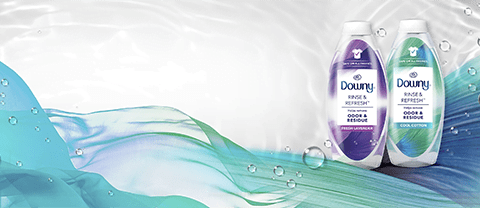CINCINNATI–The Procter & Gamble Company (NYSE:PG) reported third quarter fiscal year 2021 net sales of $18.1 billion, an increase of five percent versus the prior year. Excluding the impacts of foreign exchange, acquisitions and divestitures, organic sales increased four percent. Diluted net earnings per share were $1.26, an increase of 13% versus prior year reported EPS and eight percent versus prior year Core EPS.
Operating cash flow was $4.1 billion for the quarter. Free cash flow productivity was 106%. The Company returned $5 billion of cash to shareholders via $2 billion of dividend payments and $3 billion of common stock repurchases. Earlier this month, P&G announced a 10% increase in the quarterly dividend, marking the 65th consecutive year the Company has increased its dividend. P&G has been paying a dividend for 131 consecutive years since its incorporation in 1890.
“We delivered another quarter of solid top-line, bottom-line and cash results in what continues to be a challenging operating environment,” said David Taylor, Chairman, President and Chief Executive Officer. “We remain focused on executing our strategies of superiority, productivity, constructive disruption and improving P&G’s organization and culture. These strategies enabled us to build strong business momentum before the COVID crisis and accelerate our progress during the crisis, and they remain the right strategies to deliver balanced growth and value creation over the long term.”
January – March Quarter Discussion
Net sales in the third quarter of fiscal year 2021 were $18.1 billion, a five percent increase versus the prior year. Favorable foreign exchange increased net sales for the quarter by one percentage point. Excluding the impacts of foreign exchange, acquisitions and divestitures, organic sales increased four percent, driven by two percentage points of increased pricing and two percentage points of positive mix impact. Positive mix was driven by the disproportionate growth of the higher-priced Home Care, Oral Care and Appliances categories and the North America and Greater China regions. Shipment volumes were unchanged versus the prior year.
| January – March 2021 | Volume | ForeignExchange | Price | Mix | Other (2) | Net Sales | OrganicVolume | OrganicSales | |||||||||
| Net Sales Drivers (1) | |||||||||||||||||
| Beauty | 2% | 2% | 2% | 3% | —% | 9% | 2% | 7% | |||||||||
| Grooming | —% | —% | 2% | 2% | —% | 4% | —% | 4% | |||||||||
| Health Care | —% | 1% | —% | 3% | —% | 4% | —% | 3% | |||||||||
| Fabric & Home Care | 3% | 1% | 2% | 2% | —% | 8% | 3% | 7% | |||||||||
| Baby, Feminine & Family Care | (4)% | 1% | 2% | 1% | —% | —% | (4)% | (1)% | |||||||||
| Total P&G | —% | 1% | 2% | 2% | —% | 5% | —% | 4% |
| (1) | Net sales percentage changes are approximations based on quantitative formulas that are consistently applied. | |
| (2) | Other includes the sales mix impact from acquisitions and divestitures and rounding impacts necessary to reconcile volume to net sales. |
- Beauty segment organic sales increased seven percent versus year ago. Skin and Personal Care organic sales increased high single digits primarily driven by positive mix impact from growth of super premium SK-II brand, premium innovation in North America Skin Care and increased pricing. Hair Care organic sales increased high single digits led by Greater China due to innovation, distribution growth and a low base period due to pandemic-related shutdowns. Devaluation-related price increases also contributed to Hair Care sales growth.
- Grooming segment organic sales increased four percent versus year ago. Appliances organic sales increased more than 20% due to increased demand for at-home shaving and styling products, innovation and increased pricing. Shave Care organic sales were unchanged as devaluation related price increases and growth in female blades and razors were offset by consumption declines in male blades and razors due to decreased shave frequency.
- Health Care segment organic sales increased three percent for the quarter. Oral Care organic sales increased high single digits driven by innovation and the positive mix impacts of premium products growth. Personal Health Care organic sales decreased mid-single digits primarily due to pandemic-related increases in consumer and retailer inventories in the base period and a lower than average cough, cold and flu season in the current period.
- Fabric and Home Care segment organic sales increased seven percent for the quarter. Fabric Care organic sales increased low single digits driven by innovation, marketing investments, devaluation-related price increases and positive mix from the disproportionate growth of premium forms like fabric enhancer beads. Home Care organic sales increased high teens driven by increased consumer demand for home cleaning products during the pandemic, innovation, increased marketing investments and positive mix due to the disproportionate growth of the North America region.
- Baby, Feminine and Family Care segment organic sales decreased one percent versus year ago. Baby Care organic sales decreased mid-single digits primarily driven by reduction in retailer inventories and competitive activity in the current period and pandemic-related pantry loading in the base period. Feminine Care organic sales decreased low single digits driven by category contraction in certain European markets, partially offset by positive product mix due to premium innovation growth in North America and Greater China. Family Care organic sales increased mid-single digits primarily driven by increased pricing due to lower promotional activity.
Diluted net earnings per share were $1.26, a 13% increase versus the prior year primarily driven by the increase in net sales and an 80 basis-point increase in operating margin. Diluted net earnings per share increased eight percent versus the prior year Core EPS, which excludes non-core restructuring charges in the base period. Currency-neutral net EPS also increased eight percent for the quarter versus the prior year Core EPS.
Reported gross margin increased 130 basis points versus the prior year reported gross margin. Reported gross margin increased 30 basis points versus the prior year core gross margin due to 100 basis points of non-core restructuring charges in the base period. Unfavorable foreign exchange negatively impacted gross margin by 50 basis points. On a currency-neutral basis, reported gross margin increased 80 basis points versus the prior year core gross margin driven by 120 basis points of productivity savings and 80 basis points of benefit from increased pricing, partially offset by 30 basis points negative impact from higher commodity costs and 90 basis points of unfavorable product mix, product reinvestments and other costs. Productivity savings included approximately 80 basis points of headwinds from freight cost increases.
Selling, general and administrative expense (SG&A) as a percentage of sales increased 50 basis points on a reported basis versus the prior year. SG&A as a percentage of sales increased 30 basis points versus the prior year core SG&A due to approximately 20 basis points of lower non-core restructuring charges in the base period. Foreign exchange reduced SG&A by 20 basis points. On a currency-neutral basis, reported SG&A as a percentage of sales increased 50 basis points versus the prior year core SG&A driven by 150 basis points of marketing reinvestments and approximately 110 basis points of inflation and other impacts, partially offset by 120 basis points of sales leverage benefit and 90 basis points of productivity savings from overhead and marketing expenses.
Operating profit margin increased 80 basis points versus the base period reported operating margin. Operating profit margin was unchanged versus the base period core operating margin due to approximately 80 basis points of non-core restructuring charges in the base period. Unfavorable foreign exchange negatively impacted operating margins by 30 basis points. On a currency-neutral basis, reported operating margin increased 30 basis points versus the prior year core operating margin, including total productivity cost savings of 210 basis points for the quarter.
Fiscal Year 2021 Guidance
P&G maintained its outlook for fiscal 2021 all-in and organic sales growth in the range of five to six percent versus the prior fiscal year. Foreign exchange is expected to be roughly neutral to sales growth for the fiscal year.
The Company said it continues to expect fiscal 2021 GAAP diluted net earnings per share growth in the range of eight to ten percent versus fiscal 2020 GAAP EPS of $4.96. GAAP EPS guidance includes non-core charges of $0.16 per share in fiscal 2021 for early debt retirement and of $0.16 per share in fiscal 2020 for incremental restructuring charges. P&G maintained guidance for core earnings per share growth in the range of eight to ten percent versus fiscal 2020 core EPS of $5.12. The Company said its current outlook includes headwinds of approximately $150 million after-tax from foreign exchange impacts and more than $200 million after-tax from higher freight costs. The Company now expects a headwind from commodity costs of approximately $125 million after-tax versus the previous fiscal year.
The Company is not able to reconcile its forward-looking non-GAAP cash flow measure without unreasonable efforts because the Company cannot predict the timing and amounts of discrete cash items, such as acquisitions, divestitures, or impairments, which could significantly impact GAAP results. The Company now estimates fiscal 2021 adjusted free cash flow productivity to be over 100% for the year.
P&G expects to pay more than $8 billion in dividends in fiscal 2021. The Company increased its outlook for common stock repurchase from up to $10 billion to approximately $11 billion in fiscal 2021. Combined, P&G now plans to return about $19 billion of cash to shareowners in this fiscal year.
The Company added that it has started the process of implementing price increases on its Baby Care, Feminine Care and Adult Incontinence product categories in the United States to offset a portion of the impact of rising commodity costs. P&G said the exact amount of the price increase will vary by brand and sub-brand in the range of mid-to-high single digit percentages and will go into effect in mid-September.
Forward-Looking Statements
Certain statements in this release or presentation, other than purely historical information, including estimates, projections, statements relating to our business plans, objectives, and expected operating results, and the assumptions upon which those statements are based, are “forward-looking statements” within the meaning of the Private Securities Litigation Reform Act of 1995, Section 27A of the Securities Act of 1933 and Section 21E of the Securities Exchange Act of 1934. These forward-looking statements generally are identified by the words “believe,” “project,” “expect,” “anticipate,” “estimate,” “intend,” “strategy,” “future,” “opportunity,” “plan,” “may,” “should,” “will,” “would,” “will be,” “will continue,” “will likely result,” and similar expressions. Forward-looking statements are based on current expectations and assumptions, which are subject to risks and uncertainties that may cause results to differ materially from those expressed or implied in the forward-looking statements. We undertake no obligation to update or revise publicly any forward-looking statements, whether because of new information, future events or otherwise, except to the extent required by law.
Risks and uncertainties to which our forward-looking statements are subject include, without limitation: (1) the ability to successfully manage global financial risks, including foreign currency fluctuations, currency exchange or pricing controls and localized volatility; (2) the ability to successfully manage local, regional or global economic volatility, including reduced market growth rates, and to generate sufficient income and cash flow to allow the Company to affect the expected share repurchases and dividend payments; (3) the ability to manage disruptions in credit markets or changes to our credit rating; (4) the ability to maintain key manufacturing and supply arrangements (including execution of supply chain optimizations and sole supplier and sole manufacturing plant arrangements) and to manage disruption of business due to factors outside of our control, such as natural disasters, acts of war or terrorism, or disease outbreaks; (5) the ability to successfully manage cost fluctuations and pressures, including prices of commodities and raw materials, and costs of labor, transportation, energy, pension and healthcare; (6) the ability to stay on the leading edge of innovation, obtain necessary intellectual property protections and successfully respond to changing consumer habits and technological advances attained by, and patents granted to, competitors; (7) the ability to compete with our local and global competitors in new and existing sales channels, including by successfully responding to competitive factors such as prices, promotional incentives and trade terms for products; (8) the ability to manage and maintain key customer relationships; (9) the ability to protect our reputation and brand equity by successfully managing real or perceived issues, including concerns about safety, quality, ingredients, efficacy or similar matters that may arise; (10) the ability to successfully manage the financial, legal, reputational and operational risk associated with third-party relationships, such as our suppliers, contract manufacturers, distributors, contractors and external business partners; (11) the ability to rely on and maintain key company and third party information and operational technology systems, networks and services, and maintain the security and functionality of such systems, networks and services and the data contained therein; (12) the ability to successfully manage uncertainties related to changing political conditions (including the United Kingdom’s exit from the European Union) and potential implications such as exchange rate fluctuations and market contraction; (13) the ability to successfully manage regulatory and legal requirements and matters (including, without limitation, those laws and regulations involving product liability, product and packaging composition, intellectual property, labor and employment, antitrust, data protection, tax, environmental, and accounting and financial reporting) and to resolve pending matters within current estimates; (14) the ability to manage changes in applicable tax laws and regulations including maintaining our intended tax treatment of divestiture transactions; (15) the ability to successfully manage our ongoing acquisition, divestiture and joint venture activities, in each case to achieve the Company’s overall business strategy and financial objectives, without impacting the delivery of base business objectives; (16) the ability to successfully achieve productivity improvements and cost savings and manage ongoing organizational changes, while successfully identifying, developing and retaining key employees, including in key growth markets where the availability of skilled or experienced employees may be limited; and (17) the ability to successfully manage the demand, supply, and operational challenges associated with a disease outbreak, including epidemics, pandemics, or similar widespread public health concerns (including the novel coronavirus, COVID-19, outbreak). For additional information concerning factors that could cause actual results and events to differ materially from those projected herein, please refer to our most recent 10-K/A, 10-Q and 8-K reports.





